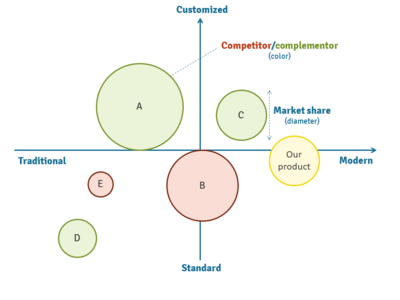Product competitors
| Product competitors |
|---|
| See also |
Product competitors compete on the same product within one class of products. Products from one class usually have different features, price and benefits but are meeting the same need. Other types of competitors, besides product competitors, are: brand competitors, generic competitors and total budget competitors. For example, in category (class) of refreshment soft drinks, product competitor would be bottled water, brand competitor would be Coca-Cola, generic competitor would be tap water and total budget competitor would be candy[1].
Product competition might be also understood as willingness to create product with the best design. An orthodox model of competition assumes that the main area of competing is to offer the lowest possible price, however nowadays unique design plays also big role in model of competition. Other aspects of competition which might impact product are: technology, supply source, type of organisation and/or delivered quality of product[2].
Analyzing product competitors
It is worth to analyze product competitors at any stage, but especially before developing new product or improving one that already exist. In the analysis, the competitor might be immediate or potencial. After analyzing competitors, evaluation of their abilities should be done. There are four levels within which competitors might be evaluated. First two are strongly connected to the product and the last two treat competition more widely[3]:
- product form competition - it is the most specific analysis, for example specific features of build-in dishwasher,
- product category competition - it is analysis of products of the same class, for example all type of dishwashers (portable dishwashers, countertop dishwashers, special dishwashers and other),
- generic competition - include substituable product categories, for example plateware or handwashing (all substitutes which are developed to meet need of washing dishes),
- budget competition - it is the broadest view and includes all products and services from the competiror side, examples will be here all products that customer might buy for the same amount of money that dishwasher costs (televisions, refrigerators, furnitures, clotes washers, clothes dryers, stoves). It might be important due to fact that sometimes if customer decides to buy several products from one retailer, he can pay less (for example for buying stove and dishwasher at once).
Author: Bartłomiej Zegarliński
Footnotes
References
- Baumol W. J., Ordover A. J. Willig D. R. (1997), Parity Pricing and Its Critics: A Necessary Condition for Efficiency in the Provision of Bottleneck Services to Competitors in Volume 14 Issue 1 Yale Journal on Regulation, Yale Journal on Regulation, USA
- Dowdle N. W., Gillespie J., Maher I. (2013), Asian Capitalism and the Regulation of Competition: Towards a Regulatory, Cambridge University Press, Great Britain
- Ferrell O. C., Hartline M. (2007), Marketing Strategy, Cengage Learning, USA
- Kahn K. B. (2015),Product Planning Essentials, M.E. Sharpe, USA
- Rácz-Molnár Z. and others (2016), Branding and extroversion handbook: a guide for SMES , Branding and Extroversion of EU enterprises project,
- Santosh K. C., Arjun M. (2017),Characterizing Product Lifecycle in Online Marketing: Sales, Trust, Revenue, and Competition Modeling, CoRR abs/1704.02993
